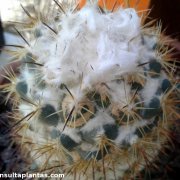Care of the cacti Coryphantha cornifera or Rhinoceros Cactus |
|
The genus Coryphantha, family Cactaceae, includes 40 species of cactus native to Mexico and the southwestern United States. Some species are: Coryphantha cornifera, Coryphantha compacta, Coryphantha andreae, Coryphantha octacantha, Coryphantha sulcata, Coryphantha werdermannii, Coryphantha durangensis, Coryphantha recurvata, Coryphantha elephantides, Coryphantha macromeris, Coryphantha ottonis, Coryphantha pallida, Coryphantha maiz-tablasensis. Common names: Rhinoceros Cactus, Prickly Beehive Cactus, Cory-cactus Edgehog, Sea Urchin Cactus. This species is native to Hidalgo, Mexico. They are easy to grow cacti with a cylindrical or globose olive-green body that can reach 15 cm (5.9") in height. The large conical tubercles appear spirally and have woolly and oval areoles. The radial spines (10-20) can be whitish or yellowish in color and the central spines can be 0-3 and are brown. The showy yellow or red flowers are funnel-shaped and reach 7 cm (2.75") in diameter. Rhinoceros Cactus is used in pots for patios, terraces, windows or very light and ventilated interiors. Coryphantha cornifera prefers light shade exposure and hot, dry climates. In winter the temperatures should be above 4 ºC (39.2 ºF). Mix 20% coarse sand with a commercial cactus soil. Water moderately as they resist drought well and are sensitive to excessive moisture. Wait until the substrate is dry and do not water in winter. Fertilize with mineral fertilizer in mid-spring. No pruning is needed. The biggest danger for Cory-cactus Edgehog is excess moisture. Sea Urchin Cactus propagates by seeds sown in spring or by rooting of the suckers if it produces them. |
Images of the cacti Coryphantha cornifera or Rhinoceros Cactus |
Find plants
Coryphantha cornifera or Rhinoceros Cactus | Care and Growing
© 2025 FavThemes




